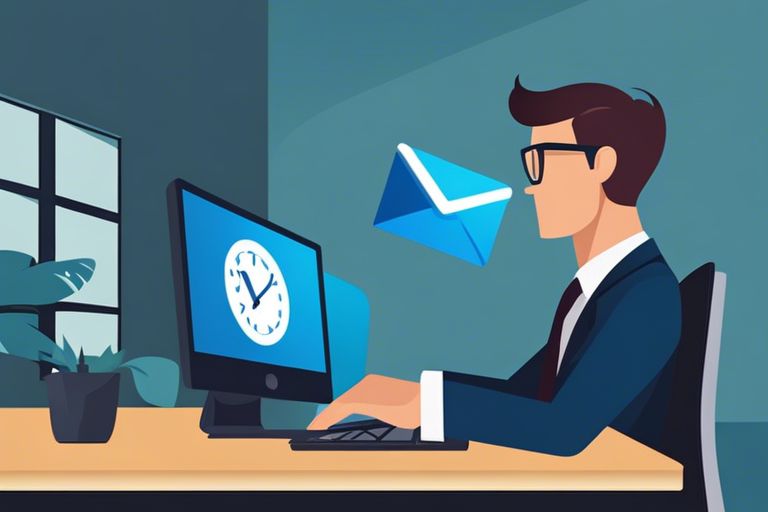Table of Contents
ToggleMany people underestimate the power of a well-executed follow-up after a job interview. Following up shows your enthusiasm for the position, reiterates your interest in the role, and distinguishes you from other candidates. It’s a critical step that can make or break your chances of landing that dream job. In this blog post, I’ll share some proven strategies on how to effectively follow up on a job interview and stand out in the hiring manager’s mind.
Key Takeaways:
- Timing is crucial: Follow up within 24-48 hours after your job interview to show your enthusiasm and interest.
- Personalize your follow-up: Mention specific details from the interview to make your message more memorable and show you were actively listening.
- Express gratitude: Thank the interviewer for the opportunity to meet and discuss the job role. Gratitude goes a long way.
- Ask for feedback: Politely inquire about the next steps in the hiring process and if there are any additional materials you can provide.
- Be persistent but not pushy: It’s okay to send a couple of follow-up emails, but don’t overwhelm the interviewer with too many messages.
- Stay professional: Keep your follow-up communication polite, professional, and free of any errors in grammar or spelling.
- Continue networking: Even if you don’t get the job, maintain a positive relationship with the company as you never know about future opportunities.

Pre-Interview Prep: What You Need to Know Before You Go
Assuming you’ve aced your job interview, it’s crucial to remember that the conversation shouldn’t end as soon as you walk out the door. Following up is a key step in the process that can set you apart from the competition. To make sure you leave a lasting impression, consider sending a Follow-Up Email After an Interview: 4 Examples and a … to keep the conversation going and show your enthusiasm for the position.
Research and Recon: Arm Yourself with Knowledge
For any job interview, it’s vital to research the company thoroughly. Check out their website, read recent press releases, follow their social media accounts, and see what current employees have to say on platforms like Glassdoor. Understanding the company’s culture, values, and recent projects can help you tailor your responses during the interview and demonstrate your genuine interest in the organization. Additionally, conducting some recon on the individuals you’ll be meeting with can give you valuable insights and help you establish a connection during the interview.
Also Read : How To Decline A Job Offer
The Blueprint: Crafting Your Follow-Up Plan
Before you hit send on that follow-up email, take a moment to craft a personalized message that highlights your qualifications, reiterates your interest in the position, and thanks the interviewer for their time. Remember to keep it concise, professional, and error-free. In your follow-up plan, consider the timeline for sending the email, whether you’ll also follow up with a handwritten note, and how you’ll continue to stay on the radar of the hiring team. Your goal is to stand out in a positive way and show that you’re proactively pursuing the opportunity.
To stand out in a sea of candidates, remember to tailor your follow-up plan to the specific interview and position. Highlight your enthusiasm for the role, reaffirm your qualifications, and show appreciation for the opportunity. By being strategic in your approach and staying top of mind with the hiring team, you increase your chances of landing that dream job. So, do your homework, craft a compelling follow-up plan, and make a lasting impression that sets you apart from the competition.
Also Read : How To Make Money Without A Job

Directly Post-Interview: The First 24-Hours
Golden Hour Tactics: What to Do Right After
To truly stand out from the competition, you need to act swiftly within the first 24 hours after your job interview. If you want to make an impression, send a quick “thank you” email to your interviewer. This shows that you are proactive and appreciative of the opportunity. Don’t procrastinate on this, as time is of the essence!
Another golden tactic is to review the key points discussed during the interview. Take notes on any important details or follow-up questions that were mentioned. This will not only help you remember the conversation better but also prepare you for any future interactions.
Writing Like a Pro: Drafting the Perfect Thank-You Note
There’s no denying the power of a well-crafted thank-you note. It is your chance to express gratitude, reiterate your interest in the position, and highlight why you are the perfect fit for the role. Make sure to personalize each note and mention specific details from the interview to show that you were actively engaged.
Writing a professional thank-you note can set you apart from other candidates and leave a lasting impression on the hiring manager. Be genuine, enthusiastic, and concise in your message, and don’t forget to proofread before hitting send. Your attention to detail and professionalism can make all the difference in landing the job!
Also Read : How To Find A Job
The Follow-Up Fundamentals: How to Nail the Timing
Keep in mind that the timing of your follow-up after a job interview is crucial. You don’t want to come off as too eager or too passive. Striking the right balance shows your interest and professionalism. But how do you determine the perfect moment to reach out?
The Waiting Game: When to Send Your Follow-Up
Clearly, you don’t want to pounce on your inbox the minute you walk out of the interview. Give it time for the dust to settle. Aim to send your follow-up within 24 to 48 hours after the interview. This timeframe shows promptness and enthusiasm without appearing desperate. If the interviewer gave you a specific timeline for their decision-making process, make sure to align your follow-up with that schedule.
When crafting your follow-up message, personalize it to reference specific points discussed during the interview. This shows attentiveness and reinforces your suitability for the role. Bear in mind, the goal is to stay top-of-mind without being a nuisance.
Frequency Factors: How Often to Reach Out
With follow-up emails, it’s important to strike a delicate balance in your approach. Sending multiple emails in a short period can be perceived as pushy, while waiting too long can signal disinterest. Ideally, aim to follow up once after your initial email if you haven’t heard back within a week. This gentle reminder demonstrates your continued interest in the position.
- Be mindful of the recipient’s time constraints and workload.
- Keep your follow-up concise and respectful.
- Perceiving your follow-up as considerate and professional is key.
Also Read : How To Respectfully Decline A Job Offer
Channels of Communication: Choosing Your Medium
Old-School Email: Why It’s Still King
On, let’s talk about the OG of communication – email. In the digital age where everything moves at the speed of light, email might seem like a dinosaur. But let me tell you, nothing packs a punch like a well-crafted email. It shows professionalism, attention to detail, and gives you the space to express yourself fully. When following up on a job interview, a concise but personalized email can make a lasting impression on the interviewer.
With email, you have the power to control the narrative. You can reiterate your interest in the position, highlight your qualifications, and address any questions or concerns that arose during the interview. Plus, email allows for easy tracking and ensures that your message doesn’t get lost in the shuffle of a busy inbox. Be mindful of, in a world full of noise, a carefully written email can be a breath of fresh air for the hiring manager.
Social Savvy: LinkedIn & Other Platforms for the Soft Touch
Some say email is old news, and that’s where social media steps in. Platforms like LinkedIn offer a more casual and interactive way to stay on the radar of potential employers. A quick message or comment on a recent post can keep you on their mind without the formality of an email. You can also use platforms like Twitter or Instagram to engage with the company’s content and show your genuine interest in their work.
Old-School doesn’t mean irrelevant. In fact, combining the power of a well-crafted email with the soft touch of social media can give you the best of both worlds. So, don’t be afraid to mix it up and show your versatility in choosing the right channel for your follow-up communication. Be mindful of, it’s all about staying top of mind in a genuine and respectful way.
Also Read : How To Get A Job
Content That Commands Attention: What to Say
Once again, you find yourself in the power position – following up on a job interview. This is your chance to showcase your personality, professionalism, and passion for the role. The key is to craft content that demands attention and sets you apart from the competition.
The Art of Remembrance: Referencing Interview Highlights
There’s nothing more impressive than demonstrating your attentiveness by referencing specific moments from the interview. Highlight key points that resonated with you or positive feedback you received from the interviewer. This shows that you were not just another candidate, but someone who truly listened and connected during the conversation.
By bringing up these memorable moments, you not only jog the interviewer’s memory but also show that you are genuinely interested in the company and the position. This level of detail-oriented follow-up can leave a lasting impression and solidify your candidacy in their minds.
Pitching Your Value: Remind Them Why You’re the One
Them: Why me? Because it’s simple – you’re the best for the job. Remind them of your unique skills, relevant experience, and passion for the industry. Paint a vivid picture of how you can contribute to their team and help them achieve their goals. Make it impossible for them to forget why you are the perfect fit.
Another important point to consider is to keep your follow-up concise but impactful. No one wants to read an essay – get straight to the point and demonstrate your value in a way that is easy for them to digest. Make every word count and leave them excited about the prospect of having you on their team.
Dealing with Silence: When There’s No Response
Despite acing the job interview and feeling confident about your qualifications, the dreaded silence that follows can be nerve-wracking. The waiting game can be excruciating, but it’s vital to stay proactive and maintain a positive mindset during this period of uncertainty.
Perseverance without Pestering: Tips for the Silent Treatment
On your quest for a job, remember that follow-up is key. It’s crucial to stay on the employer’s radar without crossing the line into pestering. Send a polite follow-up email or make a phone call to inquire about the status of your application. Keep the tone professional and courteous while expressing your continued interest in the position.
- Be persistent in your follow-ups, but respect the employer’s timeline.
- Stay proactive by continuing your job search and networking efforts.
- Remain patient and positive while awaiting a response.
Perceiving the employer’s lack of response as a sign of disinterest can be disheartening, but it’s crucial not to jump to conclusions. Keep the communication lines open and maintain a professional relationship with the company, as you never know what the future may hold.
Reading the Signs: Knowing When to Move On
The silence following a job interview can speak volumes, but don’t jump to conclusions just yet. The absence of a response may indicate that the employer is still in the decision-making process or facing internal delays.
Response may take time, but if weeks pass without any update, it may be time to read between the lines and consider shifting your focus to other opportunities. Your time and energy are valuable, so it’s important to prioritize your job search and pursue paths that align with your career goals.
Plan B Strategy: Next Steps If This One Doesn’t Pan Out
Assessment and Reflection: Valuable Takeaways from the Experience
Takeaways: Unlike dwelling on what didn’t work out, take the time to assess and reflect on the interview experience. Look at it as a learning opportunity to grow and improve. Reflect on how you presented yourself, the questions you were asked, and how you can better prepare for future interviews. Identify areas of strength and weakness so you can continue to refine your interview skills.
It’s important to view every interview as a chance to gather valuable insights about yourself and the industry you’re interested in. Do not forget, rejection is not a reflection of your worth but an opportunity to grow stronger. Embrace the lessons learned and use them to fuel your next steps towards success.
Keeping the Hustle Alive: Using Every Interview as a Stepping Stone
Next: Keep the hustle alive by leveraging every interview as a stepping stone towards your ultimate goal. Treat each interaction as a networking opportunity and a chance to expand your knowledge about the industry. Stay proactive in seeking feedback from the interviewers and continue to build your professional network.
It’s crucial to maintain a positive mindset and stay resilient in the face of setbacks. Do not forget, every interview, whether successful or not, brings you one step closer to your dream job. Use each experience to level up and position yourself for future career opportunities.
To wrap up
Ultimately, the key to success in following up on a job interview is to be genuine, thoughtful, and timely. Do not forget, you want to stay top of mind for the hiring team without becoming a nuisance. Stay proactive and take the opportunity to reiterate your interest in the role and showcase your enthusiasm for joining the team. For more tips and examples on crafting the perfect follow-up email, check out Follow-Up Email After an Interview: Examples & Templates to help you leave a lasting impression in the hiring manager’s mind.
Also Read : How To Reject A Job Offer
FAQs
Q: Why is following up on a job interview important?
A: Following up on a job interview shows persistence and enthusiasm for the position. It sets you apart from other candidates and keeps you top of mind for the hiring manager.
Q: When should I follow up after a job interview?
A: It’s best to follow up within 24-48 hours after the interview. This shows promptness and eagerness for the role. But don’t pester them – one follow-up is enough.
Q: How should I follow up on a job interview?
A: Send a thank-you email to the interviewer, expressing gratitude for the opportunity, reiterating your interest in the position, and highlighting why you are a great fit for the role.
Q: What if I haven’t heard back after following up?
A: If you haven’t heard back after following up, give it some time. It’s okay to follow up one more time politely after a week. If there’s still no response, it may be time to move on.
Q: How can I stand out when following up on a job interview?
A: Personalize your follow-up by referencing something specific from the interview that resonated with you. Show genuine interest in the company and the role to demonstrate your passion and dedication.





